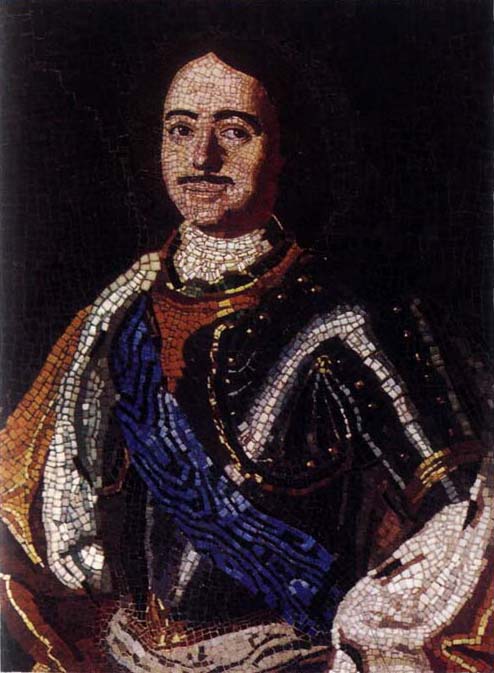
LOMONOSOV. Portrait of Peter the Great. Mosaic. 1755-57
Russian Culture: 1700-25
Rooms 152-161
Most of the items in the exhibition come from the memorial museum
of Peter the Great (called Peter the Great's Study) founded shortly after
his death and attached to the Kunstkammer (Cabinet of Curios) of the
Academy of Sciences. Documents, engravings, books, instruments, tools
and works of art all point to the important changes which took place in
Russia as a result of reforms introduced by Peter. The successful develop-
ment of the home industry may be represented by a silver bowl in the
form of a small ship, made of silver obtained from the mines of Nerchinsk
in Siberia, and by a salver of bronze from the copper works of Ekaterin-
burg. The armourer's workshops of Tula and Olonets, established during
the reign of Peter, produced guns, pistols, mortars, and a cast-iron cannon
bearing the inscription: "Olonets, 1711". There is also a large display
of astronomical, artillery and navigational instruments connected with
the creation of the Russian navy and artillery. Of further interest is a col-
lection of various medical instruments. Numerous engravings commem-
orate important events during the Great Northern War, which lasted from
1700 until 1721. Teaching tables entitled A New Method of Arithmetic,
The Mirror of the Skies and A Picture Map of the World remind us of the
fact that following the reforms carried out by Peter, the whole system of
education underwent a radical transformation and the so-called "Arithme
tic" schools (providing a general education) and special schools (naviga-
tional, artillery, medical) were organized. A printing press from the
Senate printing office made in 1721 arouses considerable interest.
Displayed in room 155 is a rare collection of duplicating lathes from
Peter's own workshop, among them the large lathe designed by the
talented mechanic Andrey Nartov (1693-1756). The details were
painstakingly made by hand, and the lathe is complete with mechanical
support.
In room 156, amongst articles turned on these lathes, is an ivory
candelabrum, certain details of which were made by Peter himself. In the
centre of the room stands the "Triumphal Column", a model of the
monument which they intended to erect on one of the squares in St
Petersburg to commemorate Russian victories in the Great Northern
War. The stem of the column consists of eight bronze cylinders with
bas-relief scenes from land and sea battles, and the column is surmount-
ed by a statue of Peter the Great, a copy of the wooden sculpture made
by Carlo Bartolommeo Rastrelli (c. 1670-1744), the father of the great
architect.
The display also includes certain memorial items, namely the uniform
and hat worn by Peter on the day of the battle of Poltava, June 9th,
1709. In room 157 are exhibited numerous objects of art and ornaments
in ivory, metal and glass,which show the development during Peter's
time of the different branches of the applied arts.
Room 158 contains works of painting, sculpture, drawing and en-
graving. Notable for its great artistic merit is the bronze bust of Peter
the Great created by the sculptor Carlo Bartolommeo Rastrelli in 1723.
The facial expression, the impetuous turn of the head reveal the complex
character of the tsar, his inflexible will, intellect and energy. On the
breastplate an allegorical scene is depicted: Peter is carving from stone
the figure of a woman wearing a royal crown, personifying the might of
Russia. Engravings by the talented craftsman Alexey Zubov (1682-after
1744), outstanding among which is the Petersburg Panorama (1716),
present the topographical record of the city on the Neva during the first
ten years of its existence. In a horizontal case near the window is a collec-
tion of portrait miniatures on enamel, among them a group portrait of
Peter and members of his family, the work of the famous artist Musi-
kiysky (1670/71-after 1739).
Displayed in room 159 are items of furniture and decorative objects
from the first quarter of the eighteenth century, among them the tapestry,
Peter the Great at the Battle of Poltava, indicating the achievements of
the Russian craftsmen of the St Petersburg tapestry workshop which
was set up in 1717.
Occupying pride of place in room 160 is the effigy representing Peter
seated in an armchair. The statue was created by Carlo Bartolommeo
Rastrelli in life size (Peter was 6 ft. 8 in. tall) immediately after the death
of the tsar. Wax impressions were made of the face, hands and feet, the
body was cut from wood, and the wig, according to legend, was made
from Peter's own hair. The figure is dressed in the robes worn by the tsar
at the coronation of Catherine I in 1724.